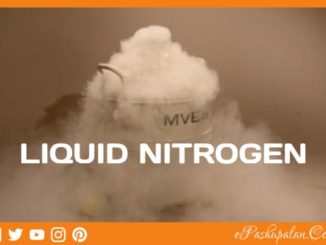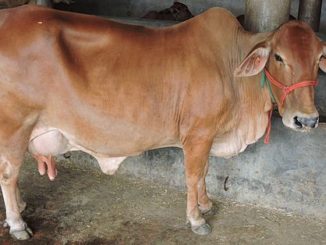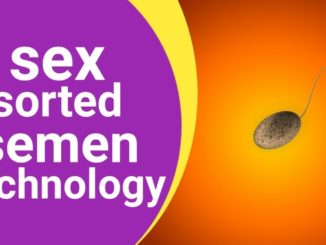Repeat breeder cow/buffalo is an animal which has failed to become pregnant when bred three cycles continuously, to a fertile bull or by AI. The animal has apparently normal genitalia with clear discharge and having normal oestrous cycle length. The animal fails to become pregnant in spite of timely inseminations with proper technique of insemination with fertile semen. In case of cows, the age of the animal should not have exceeded beyond 10 years. It is commonly noticed that, many people do not maintain proper records about the length of O.C. and consider the case as Repeat Breeder, though it may be falling into the category of acute endometritis or Early embryonic death (EED).
Major causes of Repeat Breeding (RB) includes
- Anovulatory Oestrous Cycle
- Delayed Ovulation
- Tubal blockage
- Failure of nidation of embryo
- EED (within 16 days of AI – most commonly between 4th & 10th day)
- Deficiency of oxytocin
- Deficiency of energy
- Deficiency of progesterone
- Excess estrogen
- High ambient temperature & humidity
- Transport of cow/ buffalo in estrous.
- Uro-vagina
- Pneumo-vagina
Before discussing about treatment of RB, let us discuss the basic concepts regarding how stress, nutritional deficiencies etc. influence the process of reproduction. Let us also discuss the role of uterine defense mechanism (UDM) during O.C. and concepts of treatment of Endometritis or first degree Metritis.
- Morphine blocks ovulation. Opium has resemblance in action of morphine. Opium when derived endogenously is called ‘Opioid’. Endogenous opioid peptides (EOPs) are distributed throughout the brain and spinal cord in specific neuron tracks and have diverse physiological functions which regulates neuro-endocrine regulation of hypothalamus and pituatory hormones.
- The EOPs are derived from three different precursors, out of which important precursor is
Propopiomelanocortin (POMC)
- POMC gives rise to Beta-Endorphin apart from other substances like Prolactin, MSH, ACTH and beta- Lipotrophin(another EOP). Beta-Endorphin is major opioid.
- EOP may have important interaction with hypothalamic neurons, in control of Pituatory functions.
- Stressors e.g. hypoglycemia, acute exercise and transport stimulate CRF, ACTH & concentration of B-endorphin which suppress GnRH secretion/ release, pre-ovulatory LH surge release/ tonic LH release or LH release response to GnRH, ACTH has also same suppressive effects on tonic & pre-ovulatory LH release leads to suppression of ovulation.
- Suckling leads to increase in EOPs in hypothalamus which inhibits LH secretion and after 72 hrs of weaning, EOPs decrease and LH release increases.
- Sub optimal feeding results in prolonged Oestrous Cycle. cessation of estrous with suppression of ovulation or ovulation without estrous.
- Underfed animals also require more services per conception.
- High nutritional status also leads to low conception rate due to EED caused by low level of progesterone level in plasma.
- Nutrition plays a most important role in initiation of post-partum ovarian activity. Many high yielder cows remain in –ve energy balance for first 70 days of lactation , but during first 2-3 weeks, the energy deficit is greatest. Ovulation is delayed by 0.7 days with each increase of one Megajoule of energy deficit during first 20 days of lactation. This occurs due to alteration in frequency of episodic release of LH for ovarian follicular development and ovulation. This leads to decreased Insulin concentration due to –ve energy balance in early lactation, which may render ovarian follicles less responsive to the gonadotrophin.
Uterine Defence Mechanism(UDM) during Oestrous Cycle
It is well known fact that uterus is more susceptible to infections during luteal phase and is highly resistant to infections during follicular phase of O.C. This may be due to;
During Follicular phase,
- Uterine motility helps in physical clearance of bacteria.
- Secretion of IgE is maximum and B-lymphocytes number is increasesd
- Increase in N-actyl-B-D-glucosaminidase which inhibits bacterial growth.
During Luteal phase, .
- There is less infiltration of PMN in uterus
- Bacterial activity of Myeloperoxidase enzyme of neutrophills decreases.
- Secretion of lymphocyte proliferation inhibiting factor starts and hence less Ig are formed.
- Uterine motility is decreased.
- Low intra-uterine pH provides more suitable environment for bacterial growth.
- Polysaccharide presence affects PMN surface receptors and inhibits phagocytosis.
Current & future alternative therapies for bovine Endometritis / Ist Degree Metritis :-
Diagnosis of Endometritis / Ist degree Metritis on the basis of clinical manifestations and rectal examination is not reliable and hence we always treat the cow with various drugs to cure infection and avoid RB. In general, the current therapies of Endometritis / Ist degree Metritis and uterine infections, can be classified into 4 major types;
Antibiotics
These have been widely used as treatment of uterine infections, but success of these treatments varies from beneficial to no benefit.
- When Penicillin is used, it may be inactivated through bacterial production of the enzyme Penicillinase.
- In case of Tetracyclines, the need of large systemic dose to get effective tissue concentration against Arcanobactor pyogenes could be toxic to the animal.
- The anaerobic environment of the uterus makes Aminoglycoside groupb(Gentamicin, Kanamicin, Streptomycin & Neomycin ) ineffective because of the regular need of the oxygen for their activity.
These antibiotics also inhibit phagocytosis. This suppression of leukocytic activity is further increased, if the bacteria are resistant to the antibiotic applied. In endometritis, the absorption of many drugs is diminished, due to which therapeutic levels in the deeper layers of the uterus and other parts of genital tract are not likely to be achieved.
Sulfonamides
Bactericidal activity of sulfonamides, Aminoglycosides &Nitrofurazones is greatly reduced in an environment containing blood, pus, necrotic tissue and products of tissue damage & leukocytes.
Antiseptics
Weak or dilute Lugol ’s Iodine solution has been an effective treatment of endometritis.
Hormonal Therapy
- Estrogens: Leukocytic infiltration to the uterus, uterine contractions , mucus flow and phagocytosis.
Dose of Estradiol benzoate given I/M is small i.e. 5 –10mg.
However, long acting estrogens and Stilbestrol have been associated with more severe infections of oviducts & myometrium and development of cystic ovaries.
- Oxytocin: It increases phagocytosis. The effect can be seen upto8 days post partum, if involution has been delayed.
- Prostaglandin F2α analogues: It brings about luteolysis & decreases Progesteron induced inhibition of UDM and increases estrogen induced UDM.
It has been observed that systemic use of antibiotics gives better results. Only a double dose of an antibiotic is required to achieve the optimum level of drug in the uterine lumen.
Doses Recommendation For Antibiotics
- Penicillins :- It is rapidly absorbed following intra uterine infusion, reaching peak plasma concentration in 1 hr. and decline below MIC after 4 hrs. Crystalline Penicillin G (1 million IU ) & Procaine Penicillin ( 1 million IU ) maimtained detectable levels 24 & 48 hrs, post-infusion respectively. Benzyl Penicillin following I/M route at 22000 IU / kg body wt. peak levels in blood & endometrial tissue were attained 15 & 60 minutes post-administration, respectively and remained for longer periods of time.
- Ampicillin :- I/M @ 4-6 mg/kg b.w. – needs to be repeated at 24 hrs. Intra-uterine 3 gms- needs to be repeated at 24 hrs.
- Cephalexin :- I/V @ 15 mg/kg b.w.- needs to be repeated at 9 hrs.
- Aminoglycosides :- Dihydrostreptomycins attain peak 1-2 hrs following I/Ut. Intra- uterine dose is 1 gm. Detectable conc. remains for 24 hrs in uterine lumen.
- Gentamicin : – I/M administration @ 5mg/kg is found in uterine lumen after 30 min.Needs to be repeated at 12 hrs.
- Tetracyclines :- I/V twice daily@ 9-11 mg/kg b.w. It doesn’t give good results I/Uterine.
- Chloramphenicol :- Gives better results in uterine infection. I/M @ 20 mg/kg b.w. attains serum peak in 30 min. Needs to be repeated at 10 hrs in normal cycling & 12 hrs in animals suffering from dystokia.
- Sulfonamides :- Sulfonamides @ 80 mg/kg b.w. as loading dose and 65 mg/kg as maintenance dose provides antimicrobial cover to uterus upto 14 hrs. Repeat after 24 hrs.
Future Therapy For Bovine Endometritis
(Ist Degree Metritis)
This is mainly based on using substances which cause activation of UDM . These substances are E. coli endotoxins, Serum plasma & hyperimmune serum, PMN extracts and Component Granululocyte-Macrophage colony stimulating factor and 1-10 % Oyster glycogen.
Efficacy of uterine treatments in bovines (With Antimicrobials)
- More effort is needed to improve sanitation and management practices in post partum uterine infections in individual herds / cows than using I/Ut antibiotics.
- Cows that are not severely affected will most likely resolve these infections with their own inherent defence mechanisms. Antimicrobial therapy may not offer any advantage.
- Cows severely affected by uterine infections may suffer from some degree of impairment of fertility, whether or not treated, since, the value of intra-uterine antibiotics in cycling and RB cows is questionable.
- Fungi and yeast become prevalent due to excessive use of I /Uterine broad spectrum antibiotics.
- Mild & localized uterine infection can be treated with antimicrobial therapy I/Ut except Aminoglycosides.
Anovulatory heat and delayed Ovulation
- In both the conditions, record the location of follicle on ovary. Examine the ovary for 2-3th or more days at 24 hrs interval as well as on 10 and 17 day of oestrous in cow.
- In delayed ovulation, examine animal till you find ovulation and CL size on 10 and 17 day after heat. If ovulation occurs after 24 hrs. after the end of oestrous, it is delayed ovulation.
- In anovulation, ovulation will not be there and hence no CL will be felt on above mentioned days of examination.
Treatment for delayed Ovulation
- Inject HCG or LH preparations 1500 to 3000 IU I/V on the day of AI. Give antihistaminic before HCG or LH Inj.
- GnRH i.e. Receptal or Gynarich 10-20 mcg I/M on the day of AI.
- Inj. Bromocryptin 1 mg I/M on the day of AI.
- Inj. Copper glycinate 10 ml. I/M on the day of AI.
- Feed -Carotene daily 400-600 mg/day per cow.
- Inj. Dienoestrol ( an easily assimilable estrogen) by Ethinor Lab. 5 mg S/C in early oestrous in the next cycle.
- Inj. Proluton depot 250 mg I/M after 4-5th day of AI
- 25% Dextrose 400 ml I/V + Inj. Vit. C 200 mg.
Treatment for anovulatory Heat
- Remove stress as discussed.
- Inject HCG or LH preparations 1500 to 3000 IU I/V in next O.C. in early estrous.
- GnRH i.e. Receptal or Gynarich 10-20 mcg I/M in early estrous.
- Inj. 25% or 20% Dextrose 400 ml I/V + Inj. Vit. C 200 mg I/V at AI .
- 10 ml Lugol’s Iodine drench for 15 days. Repeat after a month in non-responding cases or give 5% Lugol ’s Iodine I/V, slowly.
- Feed crushed Maize 1 kg. Daily for 45 days after proper soaking. Feed germinated gram 1 kg. Daily for 42 days after proper soaking.
- Feed 2 granules of Potassium iodide in concentrate mixture.
- Homeopathy drugs:- Aurun Iodum 200 x Thyroidinum 30 x Aguns castus 200x 10 pills of each, 3 times a day for 10 days.
- Feed mineral supplement daily especially containing Iodine 0.005 to 0.01 % Iodine and Manganese.
- Feed -carotene in feed.
Tubal Blockage
It is possible to diagnose the tubal blockage on careful P/R palpation. Accumulated fluids give a feeling of thickened zig-zag tube. If the blockage is uni-lateral RB does occur.
Blockage can be diagnosed by injecting 10 ml of 0.1% Phenol red sol. intra-uterine in one horn preferably at the tip of the horn ( otherwise the dye gets eliminated through external os and when get mixed with urine can result in a false +ve test) . After injecting dye, collect urine after ½ an hour to within 3 hrs. by catheterization and record color of the urine.
Preparation of 0.1% Phenol Red Solution: Phenol red 100 mg + one small crystal of NaOH added in small quantity of D.W. to dissolve the powder. Add D.W. to make 100 ml. Autoclave. If Fallopian tube is blocked, color of urine will not change. If it is not blocked, urine will turn Pink. This pink colour will remain for 12 hrs. It is preferred to carry out test for another horn during next O.C.
| The content of the articles are accurate and true to the best of the author’s knowledge. It is not meant to substitute for diagnosis, prognosis, treatment, prescription, or formal and individualized advice from a veterinary medical professional. Animals exhibiting signs and symptoms of distress should be seen by a veterinarian immediately. |






Be the first to comment